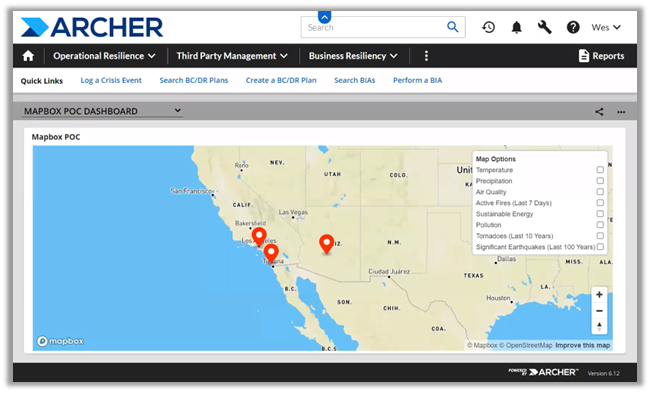How Artificial Intelligence Can Play a Critical Part in Integrated Risk Management and Resilience
- bendesj
- Jun 13, 2023
- 3 min read

Artificial Intelligence (AI) refers to computer science that focuses on creating intelligent machines capable of mimicking human cognitive abilities. AI aims to develop systems that can perceive, reason, learn, and make decisions autonomously. Machine learning (ML) is a subset of AI that focuses on algorithms and statistical models that enable computers to learn from data without being explicitly programmed.
AI can play a crucial role in enhancing business resiliency by providing advanced analytics, automation, and intelligent decision-making capabilities. For example:
McKinsey & Company’s Noble Intelligence has developed a computer-vision algorithm that assesses damage to buildings using pre-and post-disaster satellite imagery. The algorithm classifies each building into one of four categories (from “no damage” to “destroyed”) within minutes of receiving the relevant satellite data, with no human input. This quick analysis can help relief workers and organizations deploy emergency aid and allocate scarce resources more quickly.
Organizations are using AI techniques to interpret social media feeds following disasters. This type of analysis provides vital on-the-scene information about infrastructure damage and aid being provided to victims by flagging images from shelters where people are without blankets or waiting outside in the streets.
AI models can also use satellite and other data to predict at-risk areas. Damaged buildings and areas can be geo-tagged to help relief workers identify vulnerable areas and allocate resources for faster response and recovery. AI can also provide optimal route planning based on damage assessment maps for faster aid delivery in post-disaster areas. Faster damage assessments can help teams understand and provide necessary resources more quickly.
In addition to a focus on strengthening the resiliency of communities or organizations, incorporating AI results into integrated risk management (IRM) automation can significantly enhance the efficiency and effectiveness of these processes. Here is some ways AI could be incorporated with an IRM technology like Archer:
Risk Assessment and Management: AI can analyze vast amounts of data to identify risks and assess their potential impact. AI-powered risk assessment models can provide real-time insights into emerging risks, help prioritize risks based on their severity and likelihood, and support decision-making in risk mitigation strategies. These AI-generated risk assessments can be integrated into IRM automation systems, enabling automated risk monitoring, reporting, and mitigation workflows.
Data Analytics and Predictive Insights: AI-powered data analytics can be integrated into IRM automation to identify trends, patterns, and potential risks. By analyzing historical data, AI can generate predictive insights, such as identifying areas with a higher likelihood of compliance breaches or potential vulnerabilities. These insights can support proactive risk management and compliance planning.
Automating Incident Response: AI can automate parts of the incident response process, improving response time and effectiveness. AI-powered systems can analyze and correlate security alerts, assess the severity of incidents, and recommend appropriate response actions. This assists teams in managing incidents more efficiently, reducing response times, and minimizing the impact of disruptions.
Business Continuity Planning: AI can aid in developing robust business continuity plans by simulating different scenarios and predicting their impact on operations. It can model various disruptions and devise strategies to minimize downtime, ensure supply chain continuity, and maintain critical functions during crises.
Supply Chain Optimization: AI can optimize supply chain management by analyzing complex data sets, including inventory levels, demand patterns, transportation logistics, and supplier performance. It enables businesses to identify potential disruptions, optimize inventory levels, streamline logistics, and respond swiftly to changes in demand or supply.
Continuous Monitoring and Auditing: AI can facilitate continuous monitoring and auditing within IRM processes. By analyzing large volumes of data in real-time, AI algorithms can detect deviations, monitor control effectiveness, and identify potential compliance issues. These AI-driven monitoring capabilities can be integrated into IRM solutions to enable ongoing monitoring and automated auditing, reducing the need for manual sampling and periodic assessments.
Integrating AI results into IRM automation like Archer opens the floodgates to additional insight but requires careful consideration of data quality, model accuracy, and regulatory requirements. Collaboration between AI experts, IRM professionals, and IT teams is essential to ensure a robust and compliant integration between AI and IRM automation keeping in mind that AI may require human intervention to interpret the results of analyses, or to draw conclusions that drive actions.
Regular updates and validations of AI models should be conducted to maintain their effectiveness in an evolving risk and compliance landscape. While AI offers significant potential, its successful implementation requires careful consideration of ethical implications, data privacy, and transparency to build trust among stakeholders. Read this white paper to learn more about Strategies for Building Business Resiliency.
Contact us to speak to an Archer expert.


